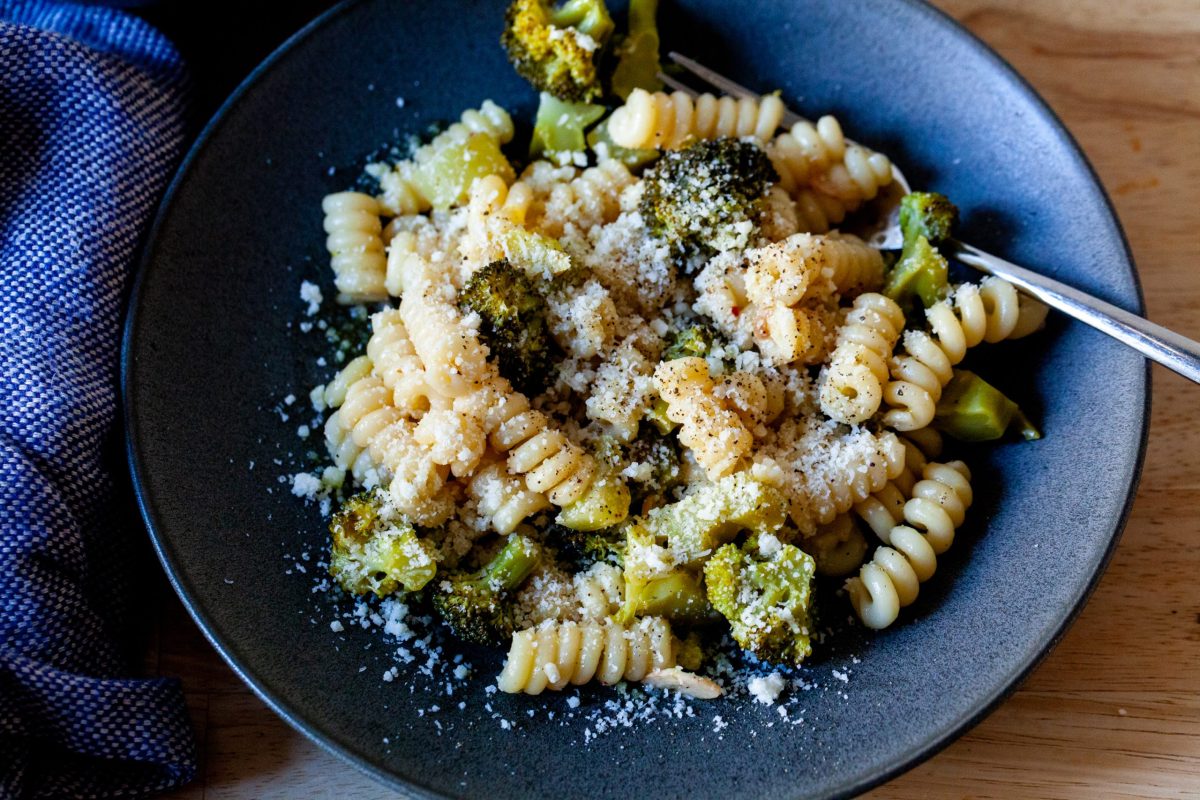
I’ve been working up the courage to tell you about this dish for a few years. Why courage, you might ask? What’s courageous about the timeless combination of broccoli and pasta, Deb? It’s the cooking time. This broccoli is not al dente. It does not “retain a crunch,” “still have some bite to it,” or keep any of the verdant green hue it entered the pan with. And, even more audacious, it doesn’t wish to. This broccoli applies a philosophy of vegetable cooking times fairly polarized from our current moment, when the minutes we walk vegetables by the fire have plunged so far that some of us even advocate for eating cauliflower, asparagus, and even broccoli raw. [Or, in a twist on the words of a steak cooking chart I once saw on the wall of a restaurant in Texas: A good farmer could still save the vegetable.]
But there is a time and place for all vegetable cookery, and this is the one that really made me fall in love with what happens when broccoli is cooked until it begins to melt. What is key is that this is not the bland, soggy, boiled to death broccoli nightmare of someone’s childhood cafeteria or dinner at grandma’s house. [Justice for grandmothers, always, however, for feeding us ingrates anyway.] This is more silky, closer to braised, and has an elusive vegetable sweetness, a nod of vegetable confit, that only comes with the luxury of the unrushed.
Which is funny because this is all in the service of a pasta-and-broccoli actually perfect for weeknights — a one-pan meal. It takes a page from an Apulian dish usually made with orecchiette and broccoli rabe (orecchiette con cime di rapa). The simplest way to make it is just to boil the vegetable and pasta together, and dress it at the end with olive oil, garlic, cheese, and seasonings as we do in this pasta with garlicky broccoli rabe. But this diverges in two ways. First, less divisive regular (Calabrese) broccoli is swapped in for broccoli rabe. The broccoli is first sauteed in a hearty glug of olive oil and a lot of aromatics — garlic, lemon zest, pepper, and anchovies, which are wonderful here even if you think you don’t like them. This step ensures that the final vegetable tastes not just boiled, but complex and fragrant when we next add both the dried pasta and water and finish cooking them together. I can’t wait for you to find out how good it is.
More
Broccoli
Pasta
Previously
6 months ago: Corn Butter Farro
1 year ago: Crispy Cabbage and Cauliflower Salad
2 year ago: Rigatoni Alla Vodka
3 years ago: Perfect Vegetable Lasagna
4 year ago: Bodega-Style Egg and Cheese Sandwich and Chocolate Puddle Cakes
5 years ago: Slow-Roasted Sweet Potatoes and Korean-Braised Short Ribs
6 years ago: Small-Batch Tiramisu
7 years ago: Miso Black Sesame Caramel Corn and Hot and Sour Soup
8 years ago: Oven-Braised Beef with Tomatoes and Garlic and Pecan Sticky Buns
9 years ago: Chocolate Hazelnut Linzer Hearts and Chocolate Peanut Butter Cheesecake
10 years ago: Italian Stuffed Cabbage
11 years ago: Lasagna Bolognese
12 years ago: Blood Orange Olive Oil Cake
13 years ago: Best Cocoa Brownies and Chana Masala
14 years ago: Chocolate Whiskey and Beer Cupcakes and Crispy Black Bean Tacos with Feta and Slaw
15 years ago: Seven-Yolk Pasta Dough and Best Chocolate Pudding
16 years ago: For Beaming, Bewitching Breads
Pasta with Longer-Cooked Broccoli
- 1 pound broccoli
- 5 tablespoons olive oil, plus more to finish
- 5 thinly sliced cloves of garlic
- 2 anchovies, roughly chopped (optional, see note)
- Zest and juice from 1/2 a lemon
- 1/4 teaspoon red pepper flakes, or to taste
- 2 teaspoons kosher salt
- Glug of white wine (optional)
- 3 cups room temperature water
- 8 ounces dried pasta such as fusilli corti or gemelli
- Grated parmesan or pecorino romano to finish (see note)
In a large deep skillet or saucepan, combine olive oil and garlic then turn heat to medium-high. Cook until the garlic is fragrant and just beginning to turn golden. Add the anchovies, if using, lemon zest and pepper flakes and cook for 2 more minutes, using a spoon or spatula to break the anchovies into tinier bits. Add a glug of wine, if using, and cook until it disappears. Add the broccoli and stems, kosher salt, and many grinds of black pepper, and cook, stirring often, for 5 minutes; the broccoli will get darker in color. Add the dried pasta and water and bring the mixture to a simmer. Cover the pan and for 12 minutes, or until the pasta is al dente. Lift the lid and stir a couple times while the pasta cooks, just to ensure it’s cooking evenly. Remove the pan from the heat and let it rest, lid on, for 5 minutes.
Remove lid, and taste for seasoning, adding more salt if needed. Finish with lemon juice, a drizzle of olive oil, additional black pepper, and grated parmesan. Spoon onto plates and serve with more parmesan.
Notes:
- Of course you don’t have to use anchovies if you don’t want to. For a similar-but-not-exactly-the-same briny addition, replace the anchovies with 1 to 2 tablespoons of drained capers. If you don’t like capers either, it’s fine. Just add neither.
- If you’d like to keep this dairy-free, you can swap the parmesan with breadcrumbs toasted lightly in olive oil and seasoned.
- Some pastas — and people (sorry!) — are thirstier than others and you might find you need an additional splash or two of pasta water to keep the dish sauced.
- I’m using a pasta shape here called fusilli corti, which I was delighted got a dedicated shoutout in Eater last fall.
Related
Credit : Source Post











